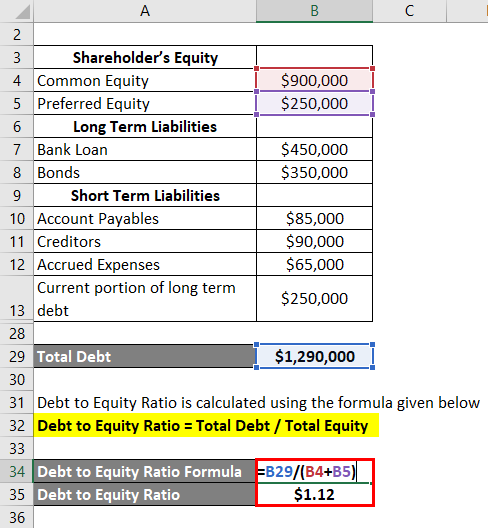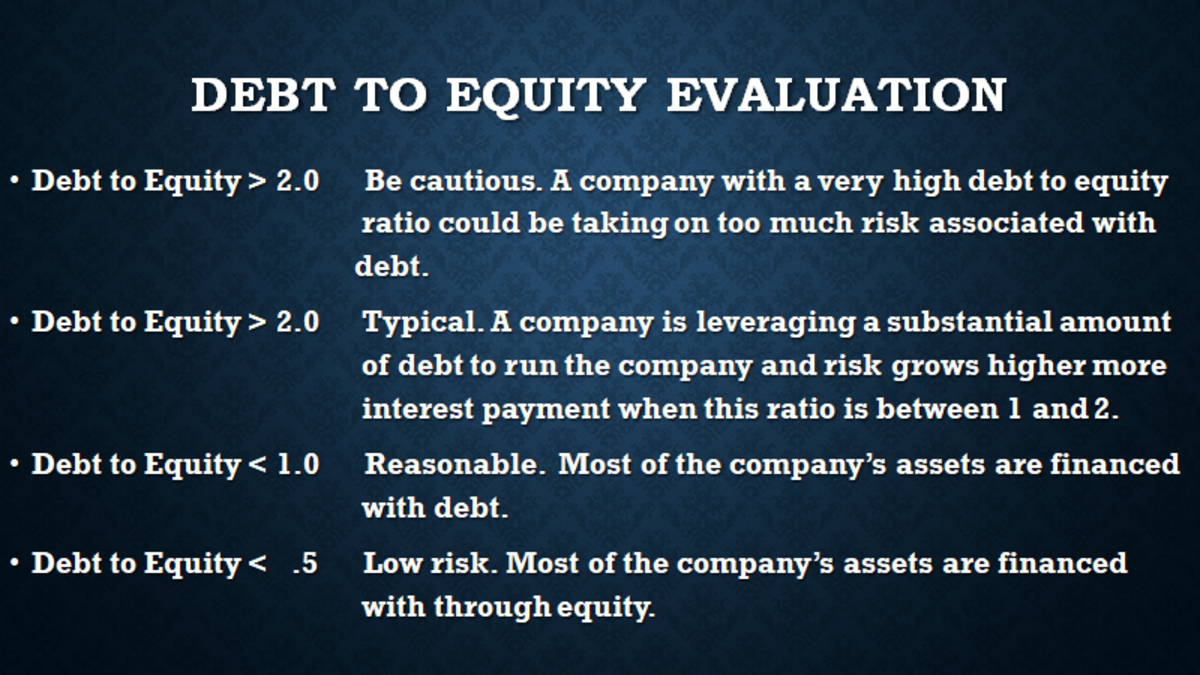
The debt-to-equity ratio (D/E) is a financial leverage ratio that can be helpful when attempting to understand a company’s economic health and if an investment is worthwhile or not. It is considered to be a gearing amortization definition ratio that compares the owner’s equity or capital to debt, or funds borrowed by the company. While taking on debt can lead to higher returns in the short term, it also increases the company’s financial risk.
Ratio Calculators
D/E ratios should always be considered on a relative basis compared to industry peers or to the same company at different points in time. A business that ignores debt financing entirely may be neglecting important growth opportunities. The benefit of debt capital is that it allows businesses to leverage a small amount of money into a much larger sum and repay it over time. This allows businesses to fund expansion projects more quickly than might otherwise be possible, theoretically increasing profits at an accelerated rate. The D/E ratio is a powerful indicator of a company’s financial stability and risk profile.

Student Loan Refinancing
To get a clearer picture and facilitate comparisons, analysts and investors will often modify the D/E ratio. They also assess the D/E ratio in the context of short-term leverage ratios, profitability, and growth expectations. How frequently a company should analyze its debt-to-equity ratio varies from company to company, but generally, companies report D/E ratios in their quarterly and annual financial statements. They may monitor D/E ratios more frequently, even monthly, to identify potential trends or issues. Economic factors such as economic downturns and interest rates affect a company’s optimal debt-to-income ratio by industry.
Debt To Equity Ratio Vs Current Ratio
For companies with steady and consistent cash flow, repaying debt happens rapidly. Also, because they repay debt quickly, these businesses will likely have solid credit, which allows them to borrow inexpensively from lenders. Not all debt is considered equally risky, however, and investors may want to consider a company’s long-term versus short-term liabilities. Generally speaking, short-term liabilities (e.g. accounts payable, wages, etc.) that would be paid within a year are considered less risky. Common debt ratios include debt-to-equity, debt-to-assets, long-term debt-to-assets, and leverage and gearing ratios. Acceptable levels of the total debt service ratio range from the mid-30s to the low-40s in percentage terms.
Lenders and investors perceive borrowers funded primarily with equity (e.g. owners’ equity, outside equity raised, retained earnings) more favorably. The D/E ratio represents the proportion of financing that came from creditors (debt) versus shareholders (equity). Assessing whether a D/E ratio is too high or low means viewing it in context, such as comparing to competitors, looking at industry averages, and analyzing cash flow.
Debt Ratio vs. Long-Term Debt to Asset Ratio
For instance, a company with $200,000 in cash and marketable securities, and $50,000 in liabilities, has a cash ratio of 4.00. This means that the company can use this cash to pay off its debts or use it for other purposes. If the company is aggressively expanding its operations and taking on more debt to finance its growth, the D/E ratio will be high. In contrast, service companies usually have lower D/E ratios because they do not need as much money to finance their operations. On the other hand, when a company sells equity, it gives up a portion of its ownership stake in the business. The investor will then participate in the company’s profits (or losses) and will expect to receive a return on their investment for as long as they hold the stock.
- Investors and accountants use debt ratios to assess the risk that a company is likely to default on its obligations.
- For example, often only the liabilities accounts that are actually labelled as “debt” on the balance sheet are used in the numerator, instead of the broader category of “total liabilities”.
- This number can tell you a lot about a company’s financial health and how it’s managing its money.
- A good D/E ratio of one industry may be a bad ratio in another and vice versa.
- Most of the information needed to calculate these ratios appears on a company’s balance sheet, save for EBIT, which appears on its profit and loss statement.
If a company’s D/E ratio significantly exceeds those of others in its industry, then its stock could be more risky. If interest rates are higher when the long-term debt comes due and needs to be refinanced, then interest expense will rise. Note that you’ll still need to know the company’s short-term liabilities to calculate shareholder’s equity.
Taking a broader view of a company and understanding the industry its in and how it operates can help to correctly interpret its D/E ratio. For example, utility companies might be required to use leverage to purchase costly assets to maintain business operations. But utility companies have steady inflows of cash, and for that reason having a higher D/E may not spell higher risk. While acceptable D/E ratios vary by industry, investors can still use this ratio to identify companies in which they want to invest.
A debt-to-equity ratio of 1.5 would indicate that the company in question has $1.50 of debt for every $1 of equity. To illustrate, suppose the company had assets of $2 million and liabilities of $1.2 million. Since equity is equal to assets minus liabilities, the company’s equity would be $800,000. Its debt-to-equity ratio would therefore be $1.2 million divided by $800,000, or 1.5. Perhaps 53.6% isn’t so bad after all when you consider that the industry average was about 75%.
A steadily rising D/E ratio may make it harder for a company to obtain financing in the future. The growing reliance on debt could eventually lead to difficulties in servicing the company’s current loan obligations. Very high D/E ratios may eventually result in a loan default or bankruptcy. If a company has a negative D/E ratio, this means that it has negative shareholder equity.



